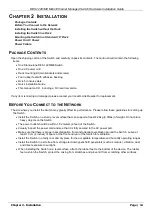
DES-1228/ME Metro Ethernet Managed Switch Hardware Installation Guide
Chapter 4 – Introduction to Switch Management
Page | 23
The default community strings for the Switch used for SNMP v.1 and v.2 management access are:
•
public - Allows authorized management stations to retrieve MIB objects.
•
private - Allows authorized management stations to retrieve and modify MIB objects.
SNMP v.3 uses a more sophisticated authentication process that is separated into two parts. The first part is to
maintain a list of users and their attributes that are allowed to act as SNMP managers. The second part describes
what each user on that list can do as an SNMP manager.
The Switch allows groups of users to be listed and configured with a shared set of privileges. The SNMP version
may also be set for a listed group of SNMP managers. Thus, you may create a group of SNMP managers that are
allowed to view read-only information or receive traps using SNMP v.1 while assigning a higher level of security to
another group, granting read/write privileges using SNMP v.3.
Using SNMP v.3 individual users or groups of SNMP managers can be allowed to perform or be restricted from
performing specific SNMP management functions. The functions allowed or restricted are defined using the Object
Identifier (OID) associated with a specific MIB. An additional layer of security is available for SNMP v.3 in that
SNMP messages may be encrypted. To read more about how to configure SNMP v.3 settings for the Switch read
the section entitled Management.
T
RAPS
Traps are messages that alert network personnel of events that occur on the Switch. The events can be as serious
as a reboot (someone accidentally turned OFF the Switch), or less serious like a port status change. The Switch
generates traps and sends them to the trap recipient (or network manager). Typical traps include trap messages
for Authentication Failure and Topology Change.
MIB
S
The Switch in the Management Information Base (MIB) stores management and counter information. The Switch
uses the standard MIB-II Management Information Base module. Consequently, values for MIB objects can be
retrieved from any SNMP-based network management software. In addition to the standard MIB-II, the Switch also
supports its own proprietary enterprise MIB as an extended Management Information Base. Specifying the MIB
Object Identifier may also retrieve the proprietary MIB. MIB values can be either read-only or read-write.
IP
A
DDRESS
A
SSIGNMENT
Each Switch must be assigned its own IP Address, which is used for communication with an SNMP network
manager or other TCP/IP application (for example BOOTP, TFTP). The Switch's default IP address is 10.90.90.90.
You can change the default Switch IP address to meet the specification of your networking address scheme.
The Switch is also assigned a unique MAC address by the factory. This MAC address cannot be changed, and can
be found by entering the command "
show switch
" into the command line interface, as shown below.
















































